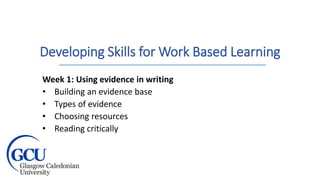
DSWBL Week 1: Using evidence in writing
- 1. Developing Skills for Work Based Learning Week 1: Using evidence in writing • Building an evidence base • Types of evidence • Choosing resources • Reading critically
- 2. In this session… • How evidence (sources or references) is used in academic writing. • What types of evidence might be used. • When to use evidence. • Taking a critical approach to using evidence.
- 3. Evidence in academic writing • Using evidence (published information such as books, journal papers or regulation documents) in written work is a standard and expected part of learning at university. • It is a way of relating your writing to the subject area and the people and organisations that contribute to knowledge and understanding of it. • As part of your studies, you will read lots of this evidence, make notes on that reading and use it to develop your own knowledge and understanding. • In your assessments, you will use that evidence to show how much you know about your subject area through a process called referencing.
- 4. What does it look like? • When you use referencing in writing, it usually looks like names and dates in brackets throughout a paragraph, or names with dates in brackets afterwards. This process allows us to discuss research, theory, definitions and demonstrate where this factual information has come from (meaning it is not our own opinion). The names may be that of one or more author or an organisation. For example: Communication is a vital part of any organisational microstructure (Samuels and Jack, 2020). Hopkins (2017) argues that this is instrumental in developing an open and collaborative work culture, in line with international organisation guidelines (SSCC, 2022).
- 5. What different types are there? • Typically you will use books, book chapters, journal articles, policy or regulation documents and some web-based publications. • When you refer to any of these in the text of your writing, you will do so using the (author, date) convention, regardless of what type of resource it is. For example: Communication is a vital part of any organisational microstructure (Samuels and Jack, 2020). Hopkins (2017) argues that this is instrumental in developing an open and collaborative work culture, in line with international organisation guidelines (SSCC, 2022). Policy document Journal article Book chapter
- 6. When should you use evidence? • Most of your assignments will ask you to write a response (of several thousand words) to a specific question. In university study, this needs to be based on fact and evidence rather than your opinion. • This is where referencing comes in. You can use references (author, date) in your text to show where statistics, data, definitions, points of view, theory, research outcomes or practice models come from. For example: 74% of respondents to the survey (Green, 2021) agreed that trains running on time ranked most highly in their good customer service expectations. This is a key performance indicator across the sector as regards operational efficiency (ROC, 2022). Data and research output Industry standard practice
- 7. Choose resources carefully • It is absolutely crucial that you choose trustworthy resources to use as evidence. Particularly when using web-based resources, it is important to take a critical (evaluative) approach – do you know who wrote a particular source and for what purpose? • Do not use resources written in a sensational way to attract attention (newspapers or magazines), or where authorship or intended audience is unclear (some blogs or Wikipedia, for example). Remember, you are not looking for opinion when you choose evidence, but facts. • Develop a strategy or checklist to help you establish relevance and rigour.
- 9. Adapted from EAPFoundation.org How to read critically http://www.eapfoundation.com/reading/critical/ Reading critically Author/source 1. Who is the author or organisation? Is the author an expert in this field? 2. What is the source of the text? Is it trustworthy? 3. When was it published? Is it recent? 4. Who is the intended audience? 5. What is the author's purpose? Is it neutral (to explain or to inform) or more biased (to persuade)? Evidence 1. How strong is the evidence? 2. re all the points made by the author supported by evidence? 3. Does the writer avoid making unsupported generalisations? 4. Is there a clear distinction between fact and the author’s opinion? 5. If there are any images or diagrams, are they clear? Do they relate to the author’s argument? Assumptions/ bias 1. Does the writer make any assumptions? Are they valid? 2. Does the writer present a balanced viewpoint? Are other viewpoints considered? 3. Are the writer's conclusions reasonable in the light of the evidence presented? 4. Is the writer's language neutral? Does the writer use tentative language (e.g. It appears that... This may be caused by...) and avoid the use of emphatic words/phrases (e.g. It is obvious...of course)? 5. Does the writer avoid using emotional language and dramatic images?
- 10. Activity Please now complete the activity in the Activities folder: Week 1: Choosing and using good quality evidence.